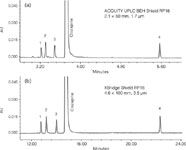Method Transfer between HPLC and UPLC using ACQUITY UPLC H-Class and Method Transfer Kits
The Application Notebook
Transferring LC methods between instruments and/or laboratory sites is a common practice that allows analytical scientists to maximize equipment usage.
Kenneth J. Fountain, Hillary Hewitson and Damian Morrison, Waters Corporation, Milford, Massachusetts, USA.
Introduction
Transferring LC methods between instruments and/or laboratory sites is a common practice that allows analytical scientists to maximize equipment usage. Although common, method transfer can be a difficult task. Differences in the properties of the LC system can produce gradient profiles that are inconsistent between the original method and the transferred method. The selectivity of the column must also remain constant when transferring from one LC to another. Complexity is added when methods are transferred between different technology platforms such as HPLC and UPLC. In this application, a method for clozapine and four impurities is transferred from UPLC to HPLC using the ACQUITY UPLC H-Class system. Selectivity of the separation is preserved by using columns with the same stationary phase that differ only in particle size.
Experimental
UPLC system: Waters ACQUITY UPLC H-Class system with PDA detector
HPLC system: Waters Alliance 2695 separations module with 2998 PDA detector
Columns: BEH Shield RP18 1.7 to 3.5 µm method transfer kit
Mobile phase A: H2O
Mobile phase B: Acetonitrile
Mobile phase C: 200 mM ammonium formate, pH 10
Sample: USP resolution mixture for clozapine (0.144 mg/mL in 80/20 MeOH/H2O)
Detection: 257 nm
Column temp.: 30 °C
Gradient, flow rate and injection volumes are specified in the figure captions. Calculations to preserve the gradient profile were performed with the new ACQUITY UPLC columns calculator.

Figure 1: Separation of clozapine and its impurities on (a) the ACQUITY UPLC H-Class system and (b) the Alliance 2695 HPLC system. UPLC gradient is from 5 to 95% B in 5 min with a constant flow of 5% C. HPLC gradient holds at 5% B for 1.91 min and then goes to 95% B in 20.6 min with a constant flow of 5% C. UPLC flow rate is 0.5 mL/min and injection volume is 2.5 µL; HPLC flow rate is 1.17 mL/min and injection volume is 24 µL.
Results and Discussion
Figure 1(a) shows the separation of the clozapine sample on a 2.1 × 50 mm, 1.7 µm BEH Shield RP18 column at high pH. All impurities were sufficiently resolved from the main active ingredient. This method was then transferred to an HPLC system using a column with identical resolving power and selectivity [Figure 1(b)]. The system dwell volumes were measured and input into the ACQUITY UPLC columns calculator to maintain the same gradient profile. Note that the selectivity between the two separations is identical and the relative retention times of each impurity to clozapine is maintained (Table 1).

Table 1: Relative retention times of impurities to clozapine for HPLC and UPLC separations.
Conclusions
The combination of the ACQUITY UPLC H-Class system and column method transfer kits facilitates the transfer of LC methods between HPLC and UPLC platforms. This allows methods to be easily transferred between systems, laboratories and sites across the world without compromising separation performance.
©2010 Waters Corporation. Waters, The Science of What's Possible, ACQUITY UPLC, XBridge and Alliance are trademarks of Waters Corporation.

Waters Corporation
34 Maple Street, Milford, Massachusetts 01757, USA
tel. +1 508 478 2000 fax +1 508 478 1990
Website: www.waters.com

Free Poster: NDSRI Risk Assessment and Trace-Level Analysis of N-Nitrosamines
April 25th 2025With increasing concern over genotoxic nitrosamine contaminants, regulatory bodies like the FDA and EMA have introduced strict guidelines following several high-profile drug recalls. This poster showcases a case study where LGC and Waters developed a UPLC/MS/MS method for quantifying trace levels of N-nitroso-sertraline in sertraline using Waters mass spectrometry and LGC reference standards.
New TRC Facility Accelerates Innovation and Delivery
April 25th 2025We’ve expanded our capabilities with a state-of-the-art, 200,000 sq ft TRC facility in Toronto, completed in 2024 and staffed by over 100 PhD- and MSc-level scientists. This investment enables the development of more innovative compounds, a broader catalogue and custom offering, and streamlined operations for faster delivery. • Our extensive range of over 100,000 high-quality research chemicals—including APIs, metabolites, and impurities in both native and stable isotope-labelled forms—provides essential tools for uncovering molecular disease mechanisms and exploring new opportunities for therapeutic intervention.
New Guide: Characterising Impurity Standards – What Defines “Good Enough?”
April 25th 2025Impurity reference standards (IRSs) are essential for accurately identifying and quantifying impurities in pharmaceutical development and manufacturing. Yet, with limited regulatory guidance on how much characterisation is truly required for different applications, selecting the right standard can be challenging. To help, LGC has developed a new interactive multimedia guide, packed with expert insights to support your decision-making and give you greater confidence when choosing the right IRS for your specific needs.
Using the Carcinogenic Potency Categorisation Approach (CPCA) to Classify N-nitrosamine Impurities
April 25th 2025Learn how to manage nitrosamine impurities in pharmaceuticals with our free infographic. Discover how the CPCA approach establishes acceptable intake limits and guides the selection of NDSRI reference samples. Stay compliant and ensure safety with our ISO-accredited standards.

.png&w=3840&q=75)

.png&w=3840&q=75)



.png&w=3840&q=75)



.png&w=3840&q=75)













